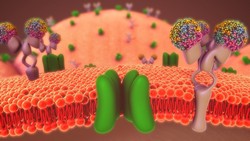New study sheds light on how cell membranes sense voltage
The electrical potential across cell membranes is sensed by specialised proteins known as voltage-gated ion channels. These channels are a type of transmembrane channel responsible for the transport of charged ions. It is just in the transmembrane region of these proteins where the electrical field changes the most; sensing the electrical field, the proteins mediate the voltage dependency opening and closing of the ion channel. Computer simulation methods have already shed some light on the molecular processes involved in the voltage-sensing modules of voltage-gated ion channels. In the EU-funded project VOLTSENS (Probing the sequence determinants of ion channel voltage sensing via computation: Towards the design of custom-tailored voltage-sensing modules), scientists wanted to further investigate the activation mechanism of the voltage-sensing modules. Specific emphasis was placed on distinguishing which markers are conserved and thus determine the function of voltage-sensing modules. First, the team used atomistic-level modelling to calculate the free energy in state transitions of the potassium channel. The study on the activation mechanism of the voltage-sensing domain of the potassium channel bridged microscopic and macroscopic views regarding ion channel dynamics and confirmed the long-suspected critical role of rate-determining barriers controlling channel gating. Using the wealth of data generated by the molecular dynamic simulations, the team proceeded with further clarifying the role of residues into the activation mechanism of the voltage-sensing domains. Results also helped shed further light onto the role of residue mutations implicated in cardiovascular diseases. Voltage-sensing modules can be envisioned as modular biomolecular machines that transduce electrical signals in cells through a highly conserved activation mechanism. Based on that, the team constructed a sequence alignment of diverse voltage-sensing sequences and searched for patterns and regularities that reflect the way evolutionary design principles control the voltage-sensor function. Models were in line with experimental findings and served to formulate testable hypotheses concerning the structural and functional properties of the voltage-sensing domains. Comparative analysis on large ensembles of sodium and potassium ion channel sequences revealed features specific to these channels and enabled the design of a model of channel gating. Project results and findings were published in peer-reviewed journals.







